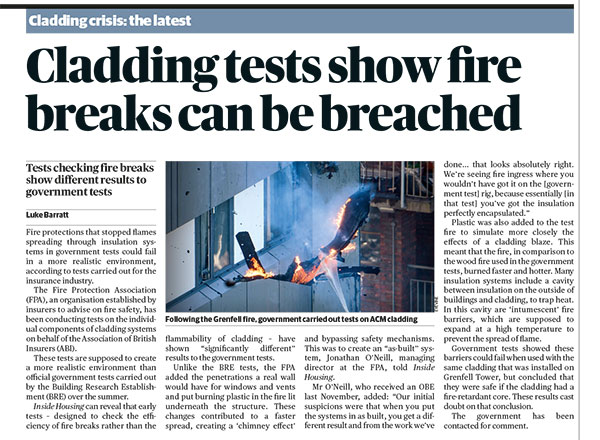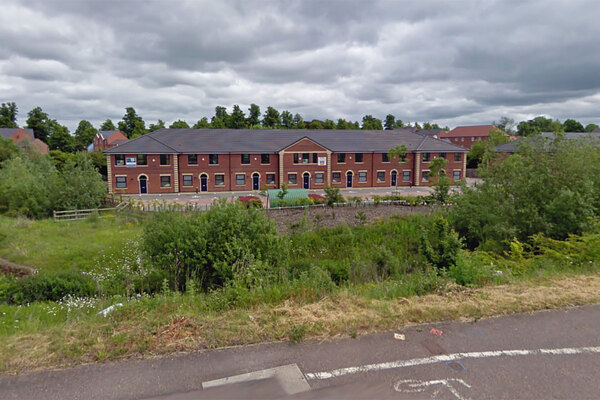A year of reporting on the Grenfell Tower fire and its far-reaching consequences for social housing
The fire at Grenfell Tower on 14 June 2017 led to the deaths of 72 people and was a profound shock to the whole country. We sum up a year of revelations and turning points since then
June 2017
23 June
Nine days after the tragedy Inside Housing launches a campaign, Never Again, aimed at preventing future disasters. It calls for immediate action to implement the learning from the Lakanal House fire, which killed six people in 2009. Among other things, it calls on landlords to commit to renewing their fire risk assessments (FRAs) annually and after major repair or cladding work is carried out. We ask the government to update and clarify building regulations and fund the retrofitting of sprinkler systems in all tower blocks across the UK.
30 June
A letter from the London Fire Brigade (LFB), obtained under the Freedom of Information Act, warned London’s social landlords to check “insulation… and infill panels” on the outside of their tower blocks as part of their risk assessments. The letter was sent the month before Grenfell. We reveal that the exterior of Grenfell had not been fire risk assessed.
July
14 July
As the full extent of the cladding crisis becomes apparent – with 224 aluminium composite material panels in 55 areas failing tests by this stage – Inside Housing leads calls for the government to meet the costs of removing the dangerous cladding from buildings. The argument ran for months, slowing down action, before the government agreed to fully fund the removal of cladding – which it estimates will cost £400m – in May 2018.
28 July
In the first major analysis of FRAs since the Grenfell tragedy, analysis of 436 tower blocks reveals the most common fire safety issues in social housing. We find 268 of the blocks have problems with fire doors that are not the correct standard or do not close properly.
August
11 August
Analysis of seven years’ worth of council papers, minutes and budgets builds up a picture of the approach to fire safety and scrutiny of the Grenfell Tower refurbishment in the years and months before the disaster. This reveals a council that had saving money at the forefront of its mind when it considered and approved the refurbishment and look at the failings following a key fire safety review in 2010.
18 August
As Sir Martin Moore-Bick, the judge picked to lead the Grenfell Inquiry, sets out his terms of reference, concerns with large-panel system (LPS) tower blocks emerge. The blocks are the same type as Ronan Point, in Newham, which collapsed in 1968, killing four people. Issues with LPS blocks continue to emerge throughout the year, and in June this year Portsmouth City Council announces it is moving residents out of two of its LPS blocks over structural concerns.
September
8 September
Freedom of Information Act (FOIA) responses from 22 London boroughs reveal that they did not include cladding in FRA checks before Grenfell. Of the respondents only Ealing, Sutton and Westminster councils had previously been checking cladding.
October
20 October
In her first interview, Maxine Holdsworth, the woman drafted in to rehouse people who lost their homes following the Grenfell Tower fire, admits there had not been enough staff to cope with the job in the days following the tragedy, and that residents’ experience “was chaotic and frightening”. She says there is “a huge amount to be learned as a result” – and that the experience demonstrates a need for councils to review their emergency planning procedures.
November
10 November
The Department for Communities and Local Government (since renamed the Ministry of Housing, Communities and Local Government) backs calls for social landlords to publish FRAs. In response to an FOIA request for its own FRA, the department says there is a public interest in “holding organisations to account as well as gaining a fuller understanding of the issues surrounding fire safety”.
December
The statement could have had ramifications for the approach taken to tackling fire safety in blocks, as it suggested the government wasn’t sure there was a system-wide problem. Our survey found the LFB had issued 87 enforcement notices on privately owned blocks since January 2015, compared to 62 on blocks owned by social landlords. FOIA requests by Inside Housing also revealed that out of 53 councils with more than one privately owned tower, 16 – or 30% – did not have information about the cladding installed on all of those blocks.
January 2018
26 January
Tests by the Fire Protection Association, an organisation established by insurers to advise on fire safety, cast doubt on some of the tests on insulation systems used by the government. They suggest that fire protections that stopped flames spreading through insulation systems in government tests could fail in a more realistic environment.
February
2 February
The government faces mounting pressure to clarify confusion over dangerous cladding, with insurers refusing to pay for its removal from buildings and insisting it complies with regulations. At the Grenfell Inquiry in early June, a report by Dr Barbara Lane, a chartered fire engineer and UK leader for the Applied Innovation and Technology Group at Arup, dismisses the argument put forward by ministers since the fire that building regulations guidance required cladding panels to be of ‘limited combustibility’ and calls for the guidance to be urgently amended.
23 February
Leaked meeting notes from giant insulation company Kingspan claim that some manufacturers have “doctored” official reports of fire safety tests on their products. The notes, seen by Inside Housing, were taken by a staff member at an internal meeting of Kingspan in September 2017. The allegation of doctoring does not refer to Kingspan itself.
March
2 March
Industry bodies express concern that calls for prescriptive building regulations to ensure the safety of high rises after the Grenfell fire are being ignored by Dame Judith Hackitt’s review of building regulations. When Dame Judith’s review is published in May it is widely criticised for failing to call for a ban on combustible cladding. Within hours of its publication the government says that it will pursue a ban.
23 March
Inside Housing publishes The Paper Trail, an investigation into the failures of building regulations which led to Grenfell. The in-depth article examines the guidance that appeared to permit the dangerous cladding used on Grenfell, reveals how regulations were slowly weakened to permit untested combinations of flammable materials to be installed on the outside of high rises and shows how an obsession with deregulation meant warning signs were missed.
April
6 April
Inside Housing shines the spotlight back on the way the sector assesses fire risk after discovering one block of flats that, due to a cock-up, had two separate FRAs carried out by different assessors. There were big differences between their findings, exposing inconsistencies with the system.
May
18 May
The official review of building regulations, carried out by Dame Judith, fails to call for a ban on combustible cladding. But she criticises the construction industry for engaging in a “race to the bottom” and calls for a regulatory body to be set up to oversee the safety of buildings.
A separate investigation by Inside Housing reveals the worrying scale of problems with LPS blocks that have emerged since Grenfell.
June
1 June
With the Grenfell Inquiry under way, documents released to Inside Housing under the FOIA reveal the government ignored calls for mandatory fire sprinklers in high rises and warnings that “a culture of poor standards” was risking lives, in consultation responses to the 2010 review of Approved Document B – its official guidance on fire safety.






























